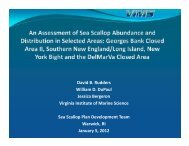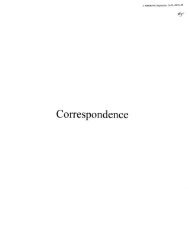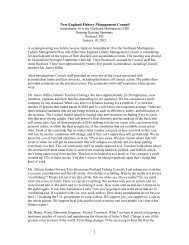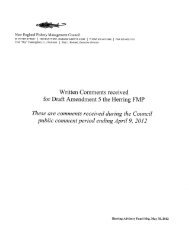Smooth Bottom Net Trawl Fishing Gear Effect on - New England ...
Smooth Bottom Net Trawl Fishing Gear Effect on - New England ...
Smooth Bottom Net Trawl Fishing Gear Effect on - New England ...
Create successful ePaper yourself
Turn your PDF publications into a flip-book with our unique Google optimized e-Paper software.
NOAA/NMFS Unallied Science Project, Cooperative Agreement NA16FL2264 December 2005<br />
<str<strong>on</strong>g>Smooth</str<strong>on</strong>g> <str<strong>on</strong>g>Bottom</str<strong>on</strong>g> <str<strong>on</strong>g>Net</str<strong>on</strong>g> <str<strong>on</strong>g>Trawl</str<strong>on</strong>g> <str<strong>on</strong>g>Fishing</str<strong>on</strong>g> <str<strong>on</strong>g>Gear</str<strong>on</strong>g> <str<strong>on</strong>g>Effect</str<strong>on</strong>g> <strong>on</strong> the Seabed:<br />
Investigati<strong>on</strong> of Temporal and Cumulative <str<strong>on</strong>g>Effect</str<strong>on</strong>g>s BKAM/CR<br />
Twenty identifiable invertebrate species were seen <strong>on</strong> the video-sled footage (Table 3.3-1- raw<br />
video sled counts). A total of 5,941 invertebrates were seen, 2,827 in Mud Hole and 3,114 in<br />
Little Tow. White sea stars (c<strong>on</strong>sisting of Asterias vulgaris and Leptasterrias tenera) were by far<br />
the most abundant invertebrates seen. They accounted for 75.8% and 58.5% of the invertebrates<br />
seen in Mud Hole and Little Tow, respectively. Shrimp were the sec<strong>on</strong>d most abundant<br />
invertebrates encountered, accounting for 33.3% of the invertebrates seen in Little Tow and<br />
23.8% of the invertebrates seen in Mud Hole. Other less numerous invertebrates seen included<br />
rock crabs (173 individuals) and scallops (52 individuals) in both areas, and sand dollars (61<br />
individuals) and sp<strong>on</strong>ges (47 individuals) <strong>on</strong>ly in Little Tow.<br />
Standardized numbers of fish and invertebrates per minute are shown in Table 3.3-2 and Figures<br />
3.3-1 and 3.3-2. The abundance of fish varied both spatially and seas<strong>on</strong>ally. Fish were generally<br />
most abundant in November, and tended to be more abundant in Mud Hole than in Little Tow.<br />
The seas<strong>on</strong>al differences in fish abundance were most pr<strong>on</strong>ounced in Mud Hole, where fish<br />
averaged from 0.47 to 1.03 individuals per minute in July and October and increased to 2.75 to<br />
3.01 individuals per minute in November (Figure 3.3-1). This seas<strong>on</strong>al increase in number of fish<br />
was c<strong>on</strong>sistent throughout all six areas of Mud Hole (Figure 3.3-3a). Seas<strong>on</strong>al differences in fish<br />
abundance were substantially less pr<strong>on</strong>ounced in Little Tow, where fish averaged from 0.10 to<br />
0.74 individuals per minute in July and October and increased to 1.16 to 1.51 individuals per<br />
minute in November (Figure 3.3-1). In additi<strong>on</strong>, the seas<strong>on</strong>al increase in number of fish was<br />
spatially inc<strong>on</strong>sistent in Little Tow, where it was observed in <strong>on</strong>ly three of the six sites (Figure<br />
3.3-3b). Fish were also much more patchily distributed in Little Tow than in Mud Hole.<br />
In both areas, most of the increase in the number of fish seen in November was attributable to the<br />
red hake Urophycis chuss (Figure 3.3-4). This species was <strong>on</strong>ly seen in appreciable numbers in<br />
November. However, it is possible that some of the unidentified juvenile fish seen in July and<br />
October may have been juvenile red hake that were not readily identifiable <strong>on</strong> the video. The<br />
sec<strong>on</strong>d most abundant fish were flounder and they were present in roughly equal numbers during<br />
all three surveys. Flounder were also slightly more abundant in Mud Hole than in Little Tow.<br />
Silver hake were an important comp<strong>on</strong>ent of the fish fauna in both areas, were seen <strong>on</strong>ly<br />
sporadically in October, and rarely in November. The other fish c<strong>on</strong>sisted mainly of sculpin in<br />
July, and unidentified juvenile fish in October and November.<br />
Invertebrates exhibited different seas<strong>on</strong>al and spatial distributi<strong>on</strong> patterns. Invertebrates were<br />
most abundant in Mud Hole in July and most abundant in Little Tow in October (Table 3.3-2 and<br />
Figure 3.3-2). However, this overall seas<strong>on</strong>al pattern was not found throughout the study areas.<br />
The northern regi<strong>on</strong> of Mud Hole generally supported far fewer invertebrates than the southern<br />
regi<strong>on</strong> (Figure 3.3-5a). Additi<strong>on</strong>ally, the number of invertebrates did not vary seas<strong>on</strong>ally in the<br />
northern regi<strong>on</strong>, whereas they were substantially more abundant in the southern regi<strong>on</strong> in July.<br />
No c<strong>on</strong>sistent spatial or seas<strong>on</strong>al patterns in invertebrate density were observed in Little Tow.<br />
However, invertebrates were more abundant in October at four of the six areas surveyed (Figure<br />
3.3-5b).<br />
Two species categories, white sea star and shrimp, accounted for most of the invertebrates seen<br />
(Figure 3.3-6). Of the two, sea stars were the most ubiquitous. They were seen at all locati<strong>on</strong>s<br />
40







